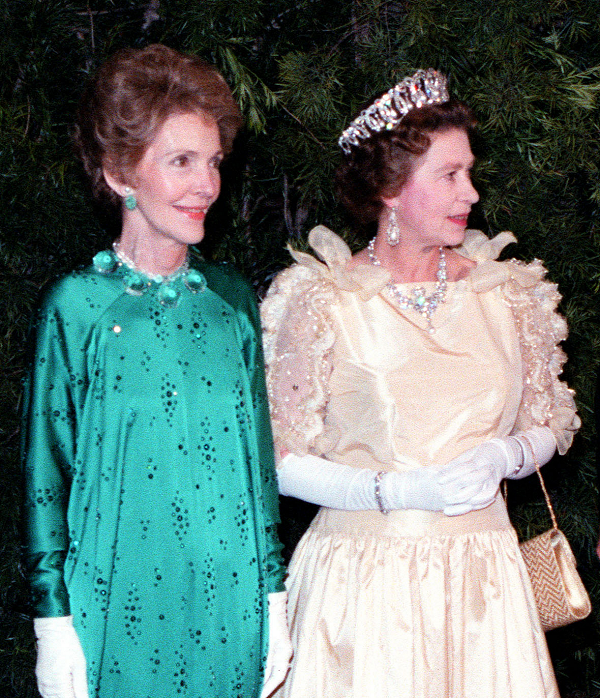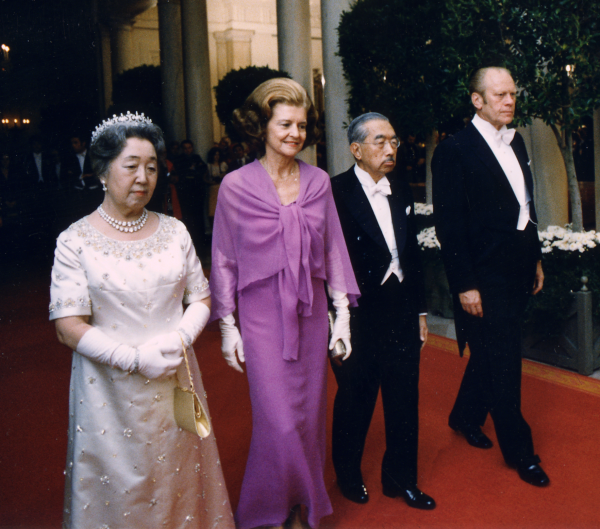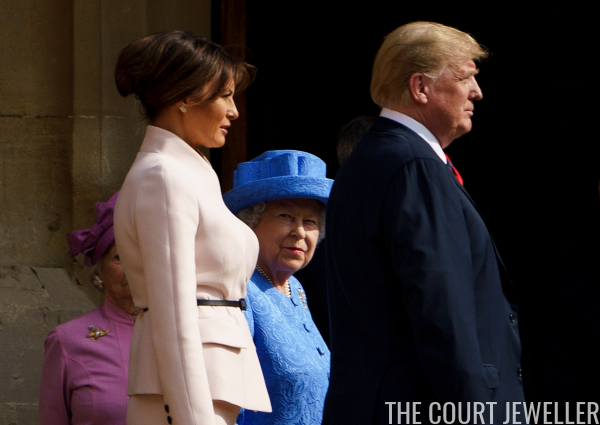 |
| The Queen meets the American President and First Lady at Windsor Castle, 13 July 2018 (BRENDAN SMIALOWSKI/AFP/Getty Images) |
In September 2015, as the Queen neared yet another royal
record – becoming Britain’s longest-reigning monarch – the historian David
Starkey paid tribute to the sovereign’s careful, non-controversial approach to
her role, dubbing her “Elizabeth the Silent.”
record – becoming Britain’s longest-reigning monarch – the historian David
Starkey paid tribute to the sovereign’s careful, non-controversial approach to
her role, dubbing her “Elizabeth the Silent.”
Indeed, silence has been a hallmark of Queen’s six
decades on the throne. In a world where everyone seems to have an opinion on
every subject, the Queen has been resolutely tight-lipped about hers. She does
not share her personal political views with the rest of us; the only hints we’ve
gotten of her politics have come second-hand, through the whispers of party-goers,
courtiers, and even the occasional indiscreet prime minister, never confirmed
and never clarified. Andrew Marr wrote in 2012 that the Queen “has never ‘confessed’
or reinvented herself. When something hurtful or wrong is reported she bites
her tongue. As a young woman she was a global superstar, but she does not play
to the media in a gushing way and certainly does not court them.” In a
monarchical world where image is everything, Marr argues, the Queen simply “has
no image” at all.
decades on the throne. In a world where everyone seems to have an opinion on
every subject, the Queen has been resolutely tight-lipped about hers. She does
not share her personal political views with the rest of us; the only hints we’ve
gotten of her politics have come second-hand, through the whispers of party-goers,
courtiers, and even the occasional indiscreet prime minister, never confirmed
and never clarified. Andrew Marr wrote in 2012 that the Queen “has never ‘confessed’
or reinvented herself. When something hurtful or wrong is reported she bites
her tongue. As a young woman she was a global superstar, but she does not play
to the media in a gushing way and certainly does not court them.” In a
monarchical world where image is everything, Marr argues, the Queen simply “has
no image” at all.
This silence – this lack of defined image – allows for
much interpretation. The Queen is a cipher: she can be everything or nothing at
the same time. Since she doesn’t express her own feelings, thoughts and
opinions are often assigned to her. She becomes a sort of mirror, reflecting
back any opinion that the holder wishes to project upon her.
much interpretation. The Queen is a cipher: she can be everything or nothing at
the same time. Since she doesn’t express her own feelings, thoughts and
opinions are often assigned to her. She becomes a sort of mirror, reflecting
back any opinion that the holder wishes to project upon her.
And that brings us to the matter at hand. This week, the
press has gone wild over one of these projections, a theory that argues that
the Queen hasn’t actually been silent at all – but instead has been
telegraphing us secret messages about her politics. Her preferred method of expression?
Her jewelry – specifically, her enormous collection of brooches, the glittering
ornaments that she pins to her coat or dress for nearly every public
engagement.
press has gone wild over one of these projections, a theory that argues that
the Queen hasn’t actually been silent at all – but instead has been
telegraphing us secret messages about her politics. Her preferred method of expression?
Her jewelry – specifically, her enormous collection of brooches, the glittering
ornaments that she pins to her coat or dress for nearly every public
engagement.
Unsurprisingly, this new theory about the politics of
Elizabeth II’s jewelry has come courtesy of two of the defining entities of 2018:
Twitter and Donald Trump.
Elizabeth II’s jewelry has come courtesy of two of the defining entities of 2018:
Twitter and Donald Trump.
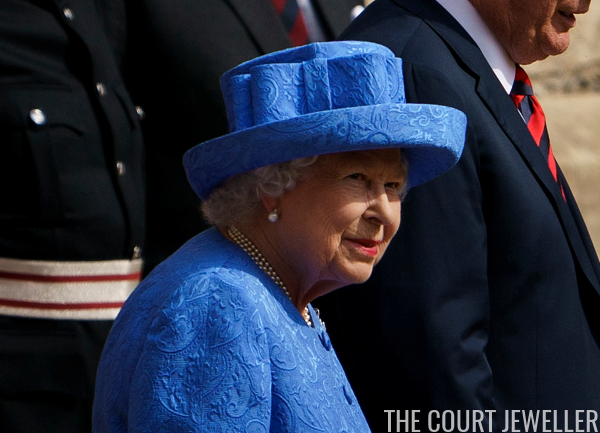 |
| The Queen meets the President at Windsor Castle, 13 July 2018 (BRENDAN SMIALOWSKI/AFP/Getty Images) |
I had really, really hoped to be able to avoid discussing
the American president’s recent visit to Britain on this site. In recent years,
I have received numerous messages from readers who are grateful for this site
as a place to escape from the overwhelming rhetoric of daily life. I won’t
argue that The Court Jeweller is completely apolitical. How could it be? Most
of the jewelry discussed here is worn by people in power, and power is
inherently political. Even so, I try very hard to make this a place where
people can discuss jewelry (and its personal and historical implications) in a
civil, friendly way, devoid of the kind of sniping and anger that seems to have
infected so many of our conversation spaces.
the American president’s recent visit to Britain on this site. In recent years,
I have received numerous messages from readers who are grateful for this site
as a place to escape from the overwhelming rhetoric of daily life. I won’t
argue that The Court Jeweller is completely apolitical. How could it be? Most
of the jewelry discussed here is worn by people in power, and power is
inherently political. Even so, I try very hard to make this a place where
people can discuss jewelry (and its personal and historical implications) in a
civil, friendly way, devoid of the kind of sniping and anger that seems to have
infected so many of our conversation spaces.
Accordingly, when it was first announced last year that
the current American president would be making his way to the United Kingdom
for an official visit with the Queen, I decided not to cover the visit on the
site. This was a personal choice. I’m not exactly the Queen (ha!), but I do try
not to discuss my own political views here, mostly because that’s not what this
place is for. As I do not hold the same views as the president, I thought it
would be best simply not to speak about him here at all, in any context. This website
was not designed to be my personal soapbox.
the current American president would be making his way to the United Kingdom
for an official visit with the Queen, I decided not to cover the visit on the
site. This was a personal choice. I’m not exactly the Queen (ha!), but I do try
not to discuss my own political views here, mostly because that’s not what this
place is for. As I do not hold the same views as the president, I thought it
would be best simply not to speak about him here at all, in any context. This website
was not designed to be my personal soapbox.
As this week has progressed, however, keeping silent
about recent events has become increasingly impossible. The Queen’s jewelry has
become the story of the presidential
visit, and I’ve been contacted by readers, members of the press, and even
family and friends asking for my opinion on the matter. The more I’ve thought
about it, the more I’ve realized that not commenting means that I’m simply
allowing others to infer my views, either correctly or incorrectly. In the end,
presenting my own views on the issues here, in a central place, as succinctly
as I can, seems like the best option.
about recent events has become increasingly impossible. The Queen’s jewelry has
become the story of the presidential
visit, and I’ve been contacted by readers, members of the press, and even
family and friends asking for my opinion on the matter. The more I’ve thought
about it, the more I’ve realized that not commenting means that I’m simply
allowing others to infer my views, either correctly or incorrectly. In the end,
presenting my own views on the issues here, in a central place, as succinctly
as I can, seems like the best option.
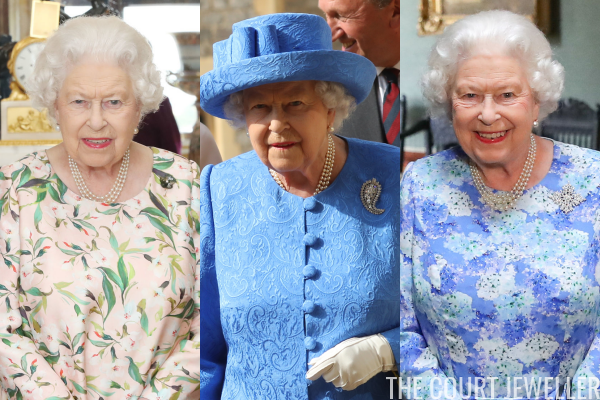 |
| The Queen’s brooches on July 12, July 13, and July 14 (Steve Parsons – WPA Pool/Getty Images, Chris Jackson/Getty Images, Andrew Matthews – WPA Pool/ Getty Images) |
Let’s get the facts straight first. (Many of the critiques
I’ve seen lobbed back and forth on this issue are preoccupied with facts, so I
think we’d better set them out clearly.)
I’ve seen lobbed back and forth on this issue are preoccupied with facts, so I
think we’d better set them out clearly.)
On Thursday, July 12, the President and the First Lady
arrived in London, where they were greeted at the airport by the
Lord-Lieutenant of Essex on behalf of the Queen. In the evening, the couple attended
a black-tie dinner alongside Prime Minister Theresa May at Blenheim Palace.
Meanwhile, at Windsor Castle, the Queen held a series of audiences with
religious leaders, meeting with the Archbishop of York, the Bishop of Bristol,
the Bishop of Carlisle, the Grand Imam of Al-Azhar, and the Archbishop of
Canterbury. During those audiences, the Queen wore a brooch that she received
in May 2011 during the last state visit from an American president: a small
floral brooch, made in America in the 1950s, consisting of moss agate and
diamonds set in gold. The Queen had previously worn the brooch for the “return
dinner” during the May 2011 state visit, a black-tie dinner hosted by President
and Mrs. Obama at Winfield House, the London home of the American ambassador.
arrived in London, where they were greeted at the airport by the
Lord-Lieutenant of Essex on behalf of the Queen. In the evening, the couple attended
a black-tie dinner alongside Prime Minister Theresa May at Blenheim Palace.
Meanwhile, at Windsor Castle, the Queen held a series of audiences with
religious leaders, meeting with the Archbishop of York, the Bishop of Bristol,
the Bishop of Carlisle, the Grand Imam of Al-Azhar, and the Archbishop of
Canterbury. During those audiences, the Queen wore a brooch that she received
in May 2011 during the last state visit from an American president: a small
floral brooch, made in America in the 1950s, consisting of moss agate and
diamonds set in gold. The Queen had previously worn the brooch for the “return
dinner” during the May 2011 state visit, a black-tie dinner hosted by President
and Mrs. Obama at Winfield House, the London home of the American ambassador.
On Friday, July 13, the Queen welcomed the President and
the First Lady to Windsor Castle, where they had tea. For this visit, the Queen
wore a diamond and platinum brooch inherited from her late mother. The brooch,
which Hugh Roberts calls “Queen Elizabeth’s Palm-Leaf Brooch,” was
ordered by the Queen Mother from Cartier in 1938. The brooch, which is made to
resemble the palm-shaped sarpech ornaments worn by Indian princes, is set with
diamonds that came from the Queen Mother’s collection. The Queen Mother wore the
Palm-Leaf Brooch extensively during her lifetime, but she did not wear it, as
has been extensively reported, for her husband’s state funeral. (Instead, she
wore the brooch a few days before, on February 11, 1952, at King’s Cross Station as King George
VI’s body was transferred to London.) When the Queen Mother
died in 2002, the Queen inherited the Palm-Leaf, and it has become one of her
most-worn brooches. One of her recent appearances in the brooch came in March
2018, when she wore it for the decommissioning of HMS Ocean in Plymouth.
the First Lady to Windsor Castle, where they had tea. For this visit, the Queen
wore a diamond and platinum brooch inherited from her late mother. The brooch,
which Hugh Roberts calls “Queen Elizabeth’s Palm-Leaf Brooch,” was
ordered by the Queen Mother from Cartier in 1938. The brooch, which is made to
resemble the palm-shaped sarpech ornaments worn by Indian princes, is set with
diamonds that came from the Queen Mother’s collection. The Queen Mother wore the
Palm-Leaf Brooch extensively during her lifetime, but she did not wear it, as
has been extensively reported, for her husband’s state funeral. (Instead, she
wore the brooch a few days before, on February 11, 1952, at King’s Cross Station as King George
VI’s body was transferred to London.) When the Queen Mother
died in 2002, the Queen inherited the Palm-Leaf, and it has become one of her
most-worn brooches. One of her recent appearances in the brooch came in March
2018, when she wore it for the decommissioning of HMS Ocean in Plymouth.
On Saturday, July 14, the Queen welcomed the King and
Queen of the Belgians to Windsor Castle, where they had tea. For this visit,
the Queen wore a new brooch set with diamonds and sapphires. The brooch,
intended to resemble a snowflake, was presented to her as a Sapphire Jubilee
gift on July 19, 2017, by the then-Governor General of Canada, David Johnston. The
brooch was made by the Saskatchewan jewelry firm Hillberg and Berk as a
companion to the Queen Mother’s Diamond Maple Leaf Brooch; the sapphires set in
the jewel were discovered on Baffin Island in 2002. This was the first time
that the Queen wore the brooch in public.
Queen of the Belgians to Windsor Castle, where they had tea. For this visit,
the Queen wore a new brooch set with diamonds and sapphires. The brooch,
intended to resemble a snowflake, was presented to her as a Sapphire Jubilee
gift on July 19, 2017, by the then-Governor General of Canada, David Johnston. The
brooch was made by the Saskatchewan jewelry firm Hillberg and Berk as a
companion to the Queen Mother’s Diamond Maple Leaf Brooch; the sapphires set in
the jewel were discovered on Baffin Island in 2002. This was the first time
that the Queen wore the brooch in public.
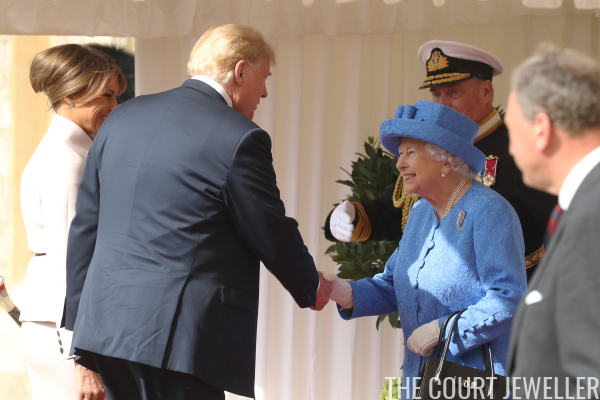 |
| The Queen greets the President and the First Lady at Windsor Castle, 13 July 2018 (CHRIS JACKSON/AFP/Getty Images) |
On Saturday, I started getting social media notifications
from users curious about the Queen’s brooch choices during the week, especially
the decision to wear the American brooch on Thursday. On Sunday, I got even more
notifications and messages, as a Twitter thread about the Queen’s brooch choices by a user named Julie (who uses the handle @SamuraiKnitter) went viral.
Julie discussed the brooches that had been worn on Thursday, Friday, and
Saturday, and concluded that the Queen was using her jewels to engage in what she
termed “brooch warfare.”
from users curious about the Queen’s brooch choices during the week, especially
the decision to wear the American brooch on Thursday. On Sunday, I got even more
notifications and messages, as a Twitter thread about the Queen’s brooch choices by a user named Julie (who uses the handle @SamuraiKnitter) went viral.
Julie discussed the brooches that had been worn on Thursday, Friday, and
Saturday, and concluded that the Queen was using her jewels to engage in what she
termed “brooch warfare.”
Julie’s theory boils down to this: she believes that the
Queen chose her brooches on Thursday, Friday, and Saturday as a way to subtly
insult Trump, essentially using a sort of code to let us know that she was
having a laugh behind his back. On Thursday, she wore a brooch that was given
to her by the President and Mrs. Obama, which Julie argues was chosen because it was given to the
Queen “out of friendship with the Obamas as people.” Friday’s Palm-Leaf
Brooch, Julie writes, was an jab because it was “the brooch her mother
wore to her father’s state funeral.” (Not quite, as stated above, but essentially she classifies it as a brooch for wearing in mourning.)
And finally, she interprets Saturday’s snowflake brooch as a gesture of confidence
from the Queen to Canada, a country that the president “has been screaming
about and insulting.” (She also notes that the Queen may have chosen it as
a reference to the use of the word “snowflake” in various political
arguments.) As a whole, her theory goes, the usually-silent Queen used her jewelry
last week to tell the world that she prefers the current president’s
predecessor, she is in mourning because of his presidency, she is on Canada’s
side (which would make sense, as she is Queen of Canada, after all), and she
thinks he’s a “snowflake.” One of Julie’s tweets in particular sums it up: “Nice way to get in a dig … without having to say a word.”
Queen chose her brooches on Thursday, Friday, and Saturday as a way to subtly
insult Trump, essentially using a sort of code to let us know that she was
having a laugh behind his back. On Thursday, she wore a brooch that was given
to her by the President and Mrs. Obama, which Julie argues was chosen because it was given to the
Queen “out of friendship with the Obamas as people.” Friday’s Palm-Leaf
Brooch, Julie writes, was an jab because it was “the brooch her mother
wore to her father’s state funeral.” (Not quite, as stated above, but essentially she classifies it as a brooch for wearing in mourning.)
And finally, she interprets Saturday’s snowflake brooch as a gesture of confidence
from the Queen to Canada, a country that the president “has been screaming
about and insulting.” (She also notes that the Queen may have chosen it as
a reference to the use of the word “snowflake” in various political
arguments.) As a whole, her theory goes, the usually-silent Queen used her jewelry
last week to tell the world that she prefers the current president’s
predecessor, she is in mourning because of his presidency, she is on Canada’s
side (which would make sense, as she is Queen of Canada, after all), and she
thinks he’s a “snowflake.” One of Julie’s tweets in particular sums it up: “Nice way to get in a dig … without having to say a word.”
The press, always eager for a fresh take on royal news
and ever hungry for clicks, has jumped on the theory. Several have also written
pieces that either support or disagree with Julie’s conclusions. There are some who have targeted
parts of her argument on a factual basis, but that’s not really the issue I
take with it personally. As I said above, the Queen’s perpetual silence on
matters of politics means that people look to any gesture from her to try to
suss out her personal feelings on issues. This “brooch warfare”
theory is basically another one of those moments. The fact that the Queen wore
these three brooches isn’t in question – it’s the interpretation of what the
brooches mean that is a matter of
debate.
and ever hungry for clicks, has jumped on the theory. Several have also written
pieces that either support or disagree with Julie’s conclusions. There are some who have targeted
parts of her argument on a factual basis, but that’s not really the issue I
take with it personally. As I said above, the Queen’s perpetual silence on
matters of politics means that people look to any gesture from her to try to
suss out her personal feelings on issues. This “brooch warfare”
theory is basically another one of those moments. The fact that the Queen wore
these three brooches isn’t in question – it’s the interpretation of what the
brooches mean that is a matter of
debate.
There’s no question that the Queen’s jewelry is often
symbolic. Julie herself writes in her Twitter thread that the Queen “does
hundreds and hundreds of appearances, and maybe 95% or higher, she wears a
brooch. And the brooch is always significant.” She’s right, although the
word always is a bit of an
overstatement. The Queen’s jewelry often does have a connection with the people
and places she visits. When organizations give her a brooch, she often wears
that brooch each time she visits them. Military badges are brought out for
appropriate events. Foreign gifts often only see the light of day when
representatives of that country encounter the Queen again.
symbolic. Julie herself writes in her Twitter thread that the Queen “does
hundreds and hundreds of appearances, and maybe 95% or higher, she wears a
brooch. And the brooch is always significant.” She’s right, although the
word always is a bit of an
overstatement. The Queen’s jewelry often does have a connection with the people
and places she visits. When organizations give her a brooch, she often wears
that brooch each time she visits them. Military badges are brought out for
appropriate events. Foreign gifts often only see the light of day when
representatives of that country encounter the Queen again.
In my opinion, the problematic logical stretch that Julie’s
theory makes is found in its interpretation of the intent behind the
jewel-wearing. The Queen often uses her brooches to make statements, but like everything
else she does, those statements are diplomatic. Jewels are used as a gesture of
acknowledgment, not insult; they’re used to build and reinforce bridges, not burn them down.
The Queen isn’t in the business of causing controversy. Her entire six decade
reign has been geared toward avoiding controversy as much as possible. She is
the living embodiment of the state, and in that representative role, she
remains studiously neutral.
theory makes is found in its interpretation of the intent behind the
jewel-wearing. The Queen often uses her brooches to make statements, but like everything
else she does, those statements are diplomatic. Jewels are used as a gesture of
acknowledgment, not insult; they’re used to build and reinforce bridges, not burn them down.
The Queen isn’t in the business of causing controversy. Her entire six decade
reign has been geared toward avoiding controversy as much as possible. She is
the living embodiment of the state, and in that representative role, she
remains studiously neutral.
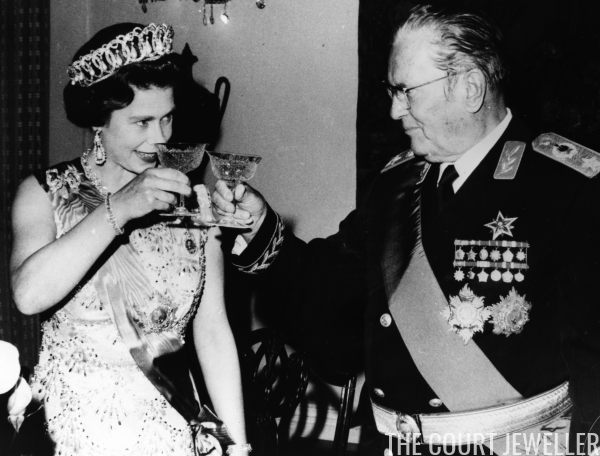 |
| The Queen and President Tito toast during a state banquet in Yugoslavia, 20 October 1972 (Central Press/Hulton Archive/Getty Images) |
Perhaps Elizabeth Windsor did have a laugh about the
president after he departed from Windsor Castle. Perhaps she finds his behavior
and his views objectionable, even repugnant. (She wouldn’t be alone.) But there’s
a difference between the Elizabeth Windsor who lives behind the closed doors of
her royal apartments and the Queen Elizabeth II who appears in public as the
monarch, the symbol of centuries of power and prestige. The Queen knows better
than to let her private self, political views included, mix with her public
persona. She’s done this for six decades, and I don’t see a reason to believe
that she’d so radically change her strategy now.
president after he departed from Windsor Castle. Perhaps she finds his behavior
and his views objectionable, even repugnant. (She wouldn’t be alone.) But there’s
a difference between the Elizabeth Windsor who lives behind the closed doors of
her royal apartments and the Queen Elizabeth II who appears in public as the
monarch, the symbol of centuries of power and prestige. The Queen knows better
than to let her private self, political views included, mix with her public
persona. She’s done this for six decades, and I don’t see a reason to believe
that she’d so radically change her strategy now.
This American president isn’t the first controversial
head of state that the Queen has met. She hosted Tito for a luncheon at
Buckingham Palace shortly before her coronation and later visited him in Yugoslavia. She presented Mugabe with a
knighthood in 1994 (an honor that was later rescinded). In 2002, she met with
Assad at Buckingham Palace. She welcomed Ceausescu for a state visit in 1978.
Historians have written about her personal, private unease with some of these
encounters, but each visit was undertaken with the same practiced, diplomatic
cool that she has perfected during her reign.
head of state that the Queen has met. She hosted Tito for a luncheon at
Buckingham Palace shortly before her coronation and later visited him in Yugoslavia. She presented Mugabe with a
knighthood in 1994 (an honor that was later rescinded). In 2002, she met with
Assad at Buckingham Palace. She welcomed Ceausescu for a state visit in 1978.
Historians have written about her personal, private unease with some of these
encounters, but each visit was undertaken with the same practiced, diplomatic
cool that she has perfected during her reign.
Lord knows, it’s tempting to want to believe that a
remarkable woman like the Queen is just like us – that she holds the same views
that we do, and laughs at the same jokes, and believes in the same truths. That,
privately, she enjoys the “trolling” and the “owning” and the
“shade” that so many on social media relish today. Part of her
success lies in the fact that her studied neutrality allows all of us to
believe that she might be with us, no matter what we believe. But the Queen is
never, ever going to tell us in certain terms what she thinks about the
political world she has inhabited for more than half a century.
remarkable woman like the Queen is just like us – that she holds the same views
that we do, and laughs at the same jokes, and believes in the same truths. That,
privately, she enjoys the “trolling” and the “owning” and the
“shade” that so many on social media relish today. Part of her
success lies in the fact that her studied neutrality allows all of us to
believe that she might be with us, no matter what we believe. But the Queen is
never, ever going to tell us in certain terms what she thinks about the
political world she has inhabited for more than half a century.
So, what we have in the end is a trio of brooches. The
first: an American brooch, one of few in her collection with ties to the States,
worn on the eve of her meeting with an American president. The second: a
glittering, personal brooch worthy of a meeting with a fellow head of state,
but worn so often that it defies easy categorization of meaning. And the third:
a gift from one of her Commonwealth realms, worn almost a year to the day after
it was presented to her. You can develop, as Julie has done, an interpretation
of the jewels that sees them as a collective attempt to jab at a political
adversary. But it’s equally possible to view the brooches as separate and
unrelated pieces, none of which were intended to insult anyone. Given the Queen’s long example of careful diplomatic behavior, the latter
interpretation makes much more sense to me.
first: an American brooch, one of few in her collection with ties to the States,
worn on the eve of her meeting with an American president. The second: a
glittering, personal brooch worthy of a meeting with a fellow head of state,
but worn so often that it defies easy categorization of meaning. And the third:
a gift from one of her Commonwealth realms, worn almost a year to the day after
it was presented to her. You can develop, as Julie has done, an interpretation
of the jewels that sees them as a collective attempt to jab at a political
adversary. But it’s equally possible to view the brooches as separate and
unrelated pieces, none of which were intended to insult anyone. Given the Queen’s long example of careful diplomatic behavior, the latter
interpretation makes much more sense to me.
I’ve read comments from many who have taken great delight in the
thought of the Queen lobbing veiled insults at Trump, a subtler version of the
way that he so casually and cruelly lobs them at others. Some have argued that,
even if the idea of the Queen’s “brooch warfare” doesn’t totally hold
water, it’s simply an entertaining story, a bit of harmless fun. Well, maybe –
but only if you see the complicated, delicate, and often fraught world of
international diplomacy as a lighthearted game. Based on her behavior over more
than six decades as head of state of one of the world’s powers, I’d argue that
it’s much more likely that Elizabeth the Silent simply doesn’t see it that way
at all.
thought of the Queen lobbing veiled insults at Trump, a subtler version of the
way that he so casually and cruelly lobs them at others. Some have argued that,
even if the idea of the Queen’s “brooch warfare” doesn’t totally hold
water, it’s simply an entertaining story, a bit of harmless fun. Well, maybe –
but only if you see the complicated, delicate, and often fraught world of
international diplomacy as a lighthearted game. Based on her behavior over more
than six decades as head of state of one of the world’s powers, I’d argue that
it’s much more likely that Elizabeth the Silent simply doesn’t see it that way
at all.
